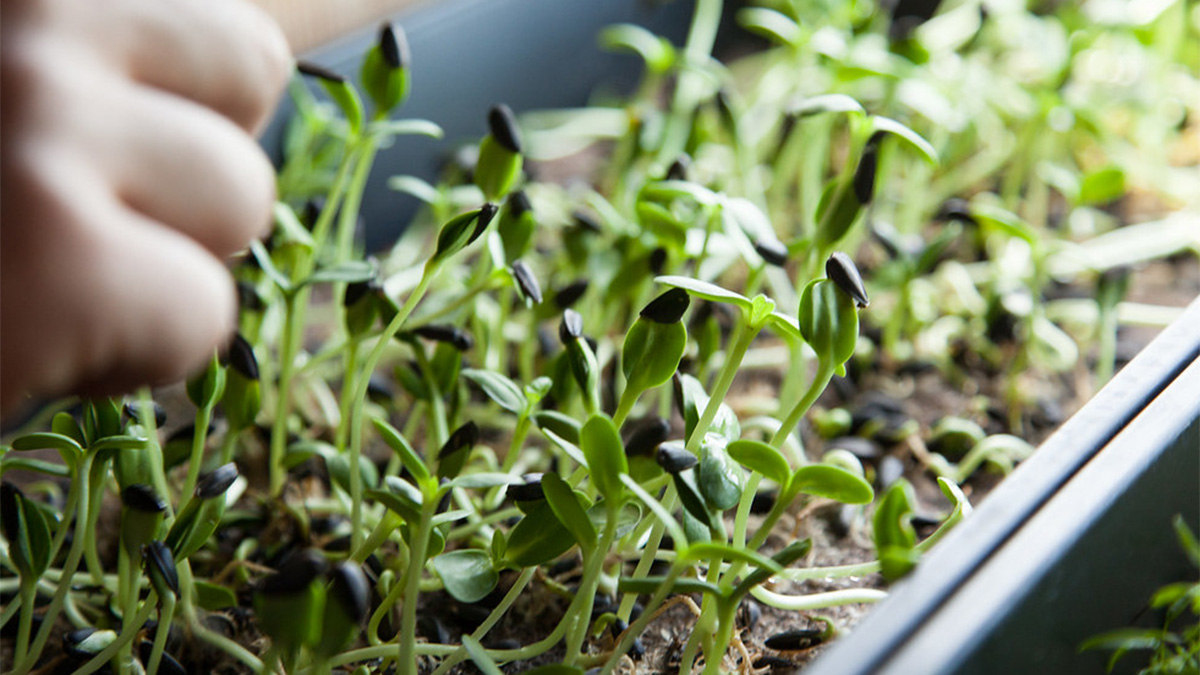Growing Microgreens at Home: Tiny Greens with Big Health Benefits

Microgreens are gaining popularity for their incredible nutritional value, simplicity, and quick growth cycle. Growing microgreens at home allows easy access to nutritious greens year-round, enhances your meals, and offers a fun and sustainable hobby.
Related: Speedy Greens: 5 Microgreens That You Can Harvest in a Week or Less
What are microgreens?
Microgreens are young seedlings of vegetables and herbs harvested just after their first leaves develop. Popular microgreens include broccoli, radish, sunflower, and pea shoots. They differ from sprouts, which grow without soil and are harvested earlier, and from baby greens, which are older and harvested after more mature leaves appear.
Benefits of growing your own microgreens
Growing microgreens at home offers significant nutritional benefits, as these tiny greens are packed with vitamins, antioxidants, and minerals. They often contain higher nutrient concentrations compared to mature vegetables. Cultivating microgreens at home is cost-effective, convenient, and ensures fresh produce without harmful chemicals or pesticides.
Essentials for growing microgreens
To grow microgreens, gather basic supplies: growing trays, soil or alternative growing mediums (such as coconut coir or hemp mats), microgreen seeds, a spray bottle for watering, and a sunny windowsill or artificial grow lights.
Growing microgreens at home
To start, gather essential supplies: a shallow growing tray with drainage holes, quality potting soil or alternative growing mediums such as coconut coir, and your chosen microgreen seeds (popular options include radish, sunflower, and broccoli). Begin by filling your tray evenly with the soil, gently pressing it down to create a flat surface. Lightly moisten the soil using a spray bottle to ensure it’s damp but not waterlogged.
Next, sprinkle your microgreen seeds evenly across the soil surface. Avoid overcrowding, but aim for dense coverage, as microgreens don’t require much space to grow. After sowing, gently press the seeds into the soil to ensure proper contact for germination. Mist the seeds lightly again with water.
Cover the tray with a second tray or plastic lid to create darkness and maintain humidity, helping the seeds germinate quickly. Keep the tray covered for 2-3 days until you notice seedlings emerging. Once seedlings begin to appear, remove the cover and place the tray in a location that provides bright, indirect sunlight or under grow lights. Keep the soil consistently moist by misting lightly daily. Avoid soaking the soil to prevent mold growth.
Within approximately 7-14 days, your microgreens should reach about 2-3 inches tall, displaying their first true leaves. At this stage, they’re ready to harvest. Use clean scissors to trim the microgreens just above the soil surface. Rinse, and they’re ready to add fresh flavor and nutrition to your meals!
Common microgreen care tips and mistakes to avoid
Proper watering is crucial; soil should remain moist but never waterlogged. Provide adequate ventilation to prevent mold and ensure even growth. Avoid common mistakes such as sowing seeds too densely, inadequate lighting, or inconsistent watering, as these can lead to disease or poor yields.
Troubleshooting common issues
Yellowing leaves often indicate insufficient light or overwatering. Wilting may result from underwatering or poor airflow. Adjusting your care practices, such as improving drainage or moving trays to better lighting can resolve these common issues, ensuring a healthy microgreen harvest.
Incorporating microgreens into your meals
Microgreens elevate the flavor, color, and nutrition of everyday dishes. Sprinkle them onto salads, sandwiches, wraps, and soups, or blend them into smoothies. Their fresh, crisp texture and bright taste enhance dishes both visually and nutritionally.
Tips for successful microgreen growing
Consistency is key. Maintain regular watering schedules, adequate lighting, and good airflow. Avoid overcrowding seeds, as competition for space and nutrients can stunt growth. Experiment with different varieties to find which microgreens grow best in your home environment and match your culinary preferences.
Conclusion
Growing microgreens at home is rewarding, nutritious, and sustainable. With basic supplies, consistent care, and a little practice, you can quickly enjoy health benefits of fresh microgreens and potentially turn your new hobby into a profitable venture.
